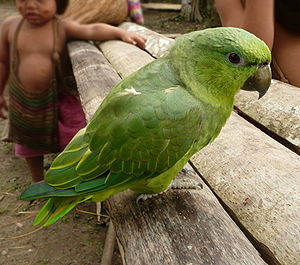Short-tailed parrot
| Short-tailed parrot | ||||||||||
|---|---|---|---|---|---|---|---|---|---|---|

A short-tailed parrot as a pet among Peruvian Indians. |
||||||||||
| Systematics | ||||||||||
|
||||||||||
| Scientific name of the genus | ||||||||||
| Graydidascalus | ||||||||||
| Bonaparte , 1854 | ||||||||||
| Scientific name of the species | ||||||||||
| Graydidascalus brachyurus | ||||||||||
| ( Kuhl , 1820) |
The short-tailed parrot ( Graydidascalus brachyurus ) is a New World parrot widespread in the Amazon region . It lives in the Varzea and secondary forests on the banks of the Amazon and its major tributaries, preferring temporarily flooded or swampy areas. Rainforests that are not periodically flooded (Terra Firma) are avoided. The animals living in the east are described by some authors as subspecies G. b. insulus from the nominate form G. b. brachyurus differentiated. In addition to the blue-bellied parrot , it is considered to be the least known parrot in South America.
features
Short-tailed parrots are similar to amazons and, like them, have a green base color. The wing feathers are lined with yellow, parts of the wing edge and the tail base are red. There is a bare zone of gray skin around the eyes, the iris is dark red, the beak blackish, the wax skin , the reins (the area between the beak and the eye) and the feet are gray. It is named after its strikingly short tail.
Young birds are similar to adults. Their bulwark base and the wing edges do not yet show any red color.
Lifestyle and diet
Short-tailed parrots live in larger groups and mainly stay in trees near rivers. In the evening they gather loudly with many conspecifics and other parrots on trees on the banks and on river islands. Short-tailed parrots feed on nuts, seeds, fruits, and berries. Also orchards where z. B. Guavas are grown, are visited by the birds.
Reproduction
Little is known about the reproduction of the species. Breeding colonies were observed in eastern Brazil in September. The eggs of captive specimens were 21.7 - 27.5 × 30.5 - 32.9 mm.
literature
- Werner Lantermann: parrot science. Parey Buchverlag Berlin, 1999, ISBN 3-8263-3174-5
Web links
- Graydidascalus brachyurus inthe IUCN 2013 Red List of Threatened Species . Listed by: BirdLife International, 2012. Retrieved September 26, 2013.